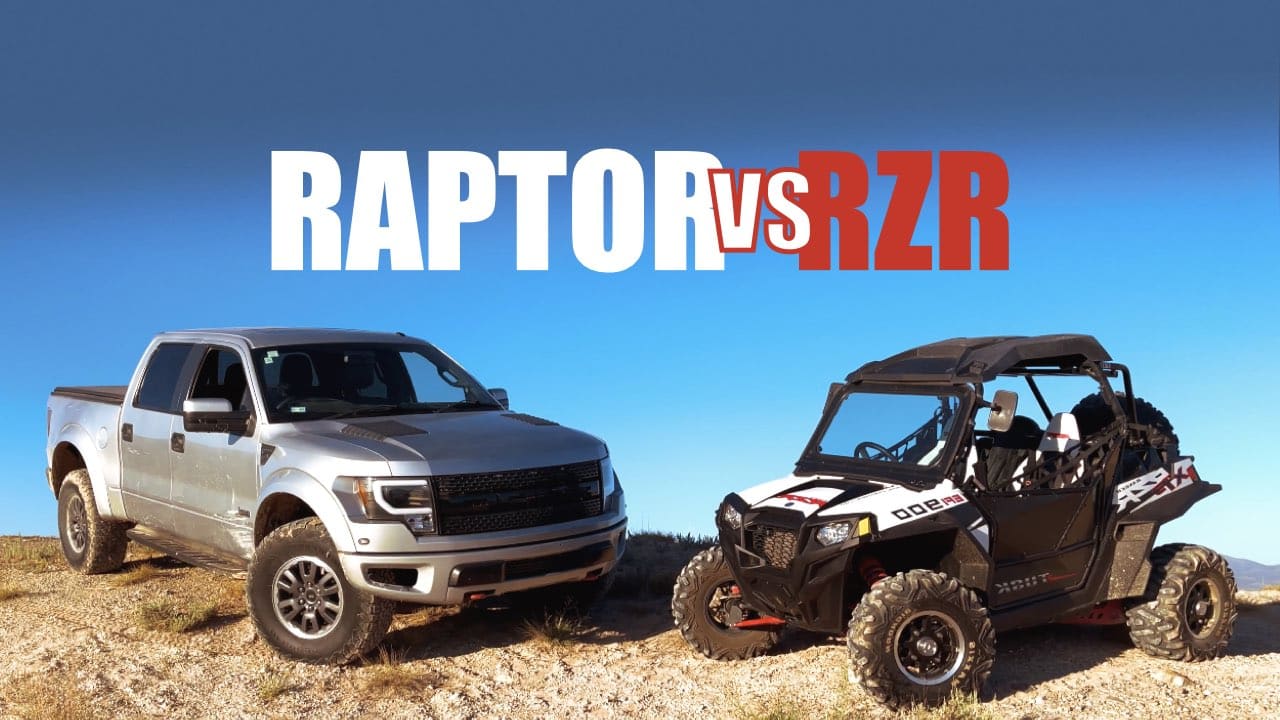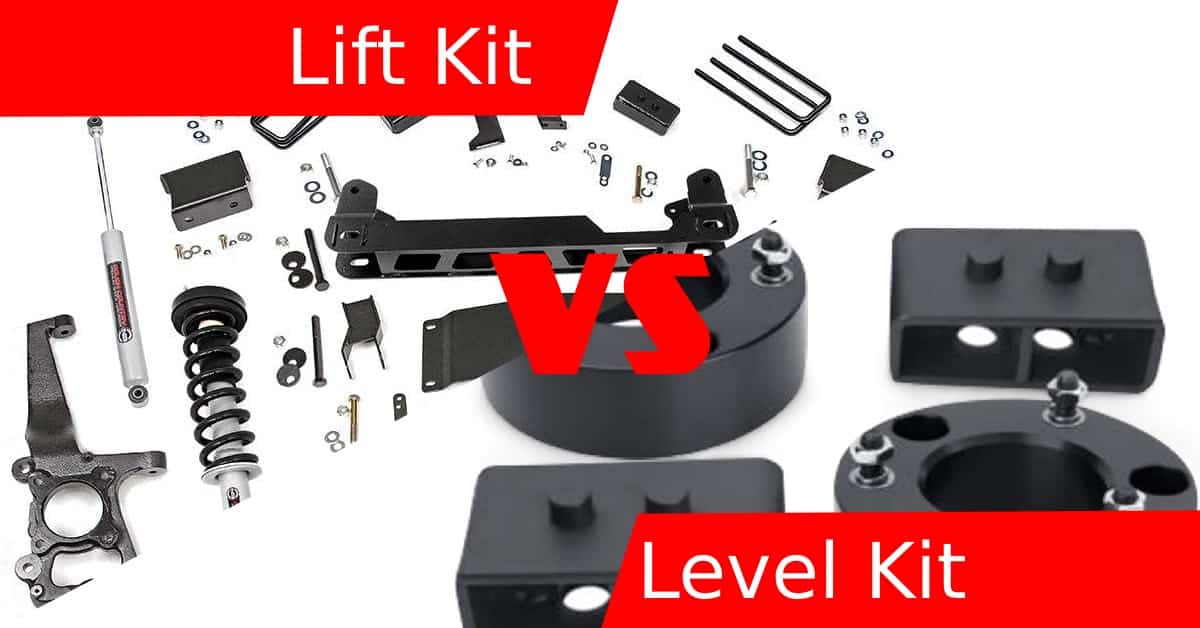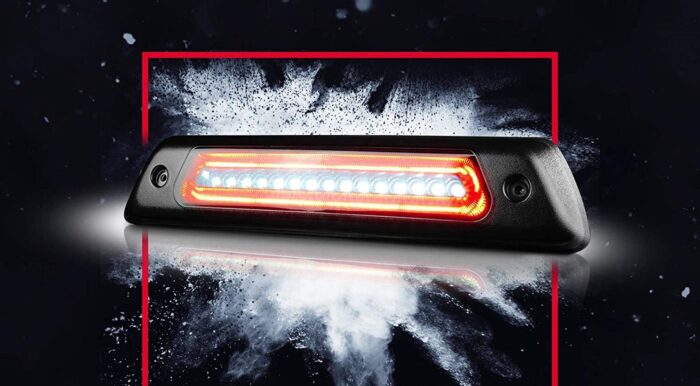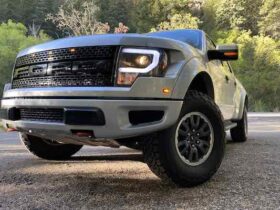Can a Gen 1 Ford Raptor beat a Polaris RZR 900 XP side-by-side in an off road race?
In our suspension shootout comparison, we take a first-gen Ford Raptor and put it head to head against a Polaris RZR 900 XP in an off-road track.
But first, let’s take a quick look at the technical specifications of each of the two vehicles:
| Polaris RZR 900 XP | Ford Raptor Gen 1 | |
| Power | 88 HP 60 TQ | 411 HP 434 TQ |
| Weight | 1190 lbs. | 6200 lbs. |
| Pounds Per Horsepower | 13.5 | 15 |
| Tires | 27” Maxxis Bighorns | 35″ BFG All Terrain |
| Shock Setup | 2.0” Fox Racing | 2.5” Fox Racing |
| Suspension Travel | Front 13.5” Rear 14” | Front 11.2” Rear 12.1” |
From the outset, it may seem like a biased fight considering the two models boast completely different specs and engine configurations.
As you can see, whereas the Raptor runs on a 411-HP engine, the Polaris RZR 900 XP is endowed with an 88-HP twin Electronic Fuel Injected (EFI) engine. Usually, the higher the horsepower, the faster the speed.
But when it comes to zipping across rolling sand dunes, horsepower has little to no say. You need the suspension – and lots of it, for that matter!
To determine how exactly the two vehicles stack up against each other, we took them out in an off-road track.
Keeping in mind that the Raptor has 323 more horsepower than the RZR, our aim was to level up the playing field between the two. We deliberately picked a spot that gives neither of the two vehicles an unfair advantage.
And so, the terrain was lengthy enough to enable the Raptor subdue its off-the-line traction deficit, but bumpy enough to let the RZR have a fair shot.
Ripping across just about a quarter-mile off-road loop that looked like a roiling ocean cast in the sand, the suspension shootout race was on.
This was the striking battle between the Polaris RZR’s ultimate suspension and the Ford Raptor’s ultimate horsepower. And our team had a few surprises along the way.
The Track
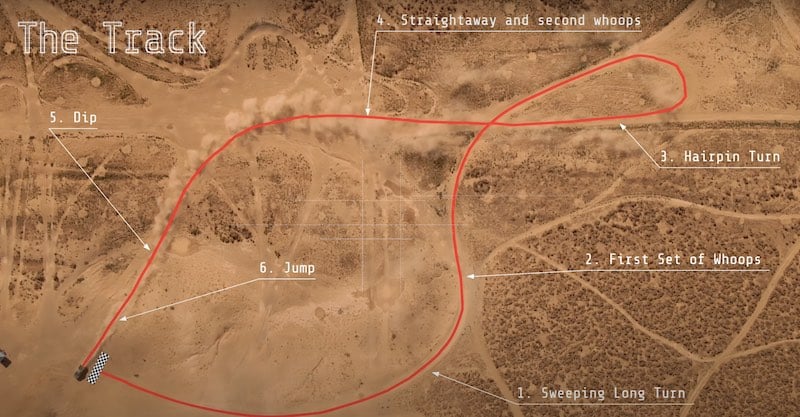
This track is a bit less than 1/2 mile and consists of
- Sweeping long, high speed turn
- First section of deep whoops
- Hair-pin turn
- Largest straight-away section and whoops
- Dip in the bowl
- Flying finish jump
This track is short but it is far from sweet. It has a combination of sharp turns, deep whoops, limited straitaways and short overall length. This design is to try and even the playing field and really test each vehicle suspension to the limits.
Gen 1 Ford Raptor Truck
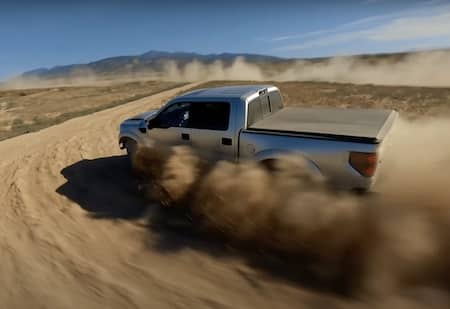
It would usually make no sense to put a street truck head to head against a purely off-road vehicle. But the Raptor is capable off-road as it is on-road.
After driving the truck a number of times around the track, we could easily tell it’s got some weight to it. Be that as it may, the two vehicles have pretty much the same power-to-weight ratios.
The Gen 1 Raptor floats over whoops and road imperfections without a hitch, getting the job done in just 48.1 seconds. It achieves a shake score of .36 G-forces with a time penalty of 6.8 seconds. That’s pretty quick!
To put it into perspective, on-road the Raptor would normally sprint from 0-60 mph in just over 5 seconds. But here, due to the role the terrain played, hitting 60 needed a steadfast faith in the handiwork of the front and rear suspension travel.
Also, the Raptor’s all-terrain tires with bead-lock wheels and Fox Racing shocks combined to soak up bumps, allowing for a smooth and comfy ride. Put simply, the truck is geared toward badass driving situations.
Polaris RZR 900 XP
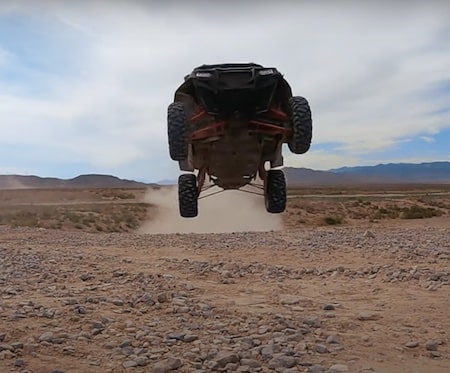
With 13.5 inches of travel up front and 14 inches in the back, the RZR outshines the Raptor in respect to suspension.
And weighing in at barely 1,500 pounds, there is no doubt the RXR is built to tear up the desert. Based on our test, the RXR is a completely different beast.
It had a time around the track of 41.0 seconds, a shake score of .32 G-forces, with a time penalty of 6.6 seconds. Its total time clocked in at 47.6 seconds. Clearly, this is a lot quicker than the Raptor as it’s built for razor-sharp, Xtreme performance off road.
By combining a front and rear suspension travel, Fox Racing shocks and Maxxis Bighorns tires, it delivers uncompromised agility and performance. It takes on any obstacle, highest dunes, and anything else thrown its way.
The car’s suspension is well tuned and effective. The shocks include compression clickers that deliver a good combination of bottoming resistance and ride quality over trail junk.
All in all, Polaris managed to hit the bull’s eye with the RXR 900 XP. It provides next-level off-road performance with adjustable shocks that create some of the best creature comforts no matter how rocky the terrain might be.
Our Head-To-Head Results
The race was so close from start to finish, with the RZR leading by just 0.5 seconds. Here’s a complete breakdown of the time score for both the Raptor and RZR:
| Polaris RZR 900 XP | Ford Raptor Gen 1 | |
| Time (Around the Track) | 41.0 Seconds | 41.3 Seconds |
| Shake Score | .32 G’s | .3 G’s |
| Time Penalty | 6.6 Seconds | 6.8 Seconds |
| Total Time | 47.6 Seconds | 48.1 Seconds |
| OUR WINNER |
You May Also Like
Of course, the Raptor would easily outshine the RZR on the street. It feels pretty quick on-road—even when towing the RZR itself!.
Throw in the rhythmic rolling sand dunes and perpendicular cuts, and the Raptor would struggle maintaining contact and transforming the torque into forward motion.
Though the RZR’s suspension components had the clear advantage off the line, the Raptor maintained the pace throughout the race. At the end, it was the RZR who won by a nose—but the two are equally amazing machines worth every penny.
